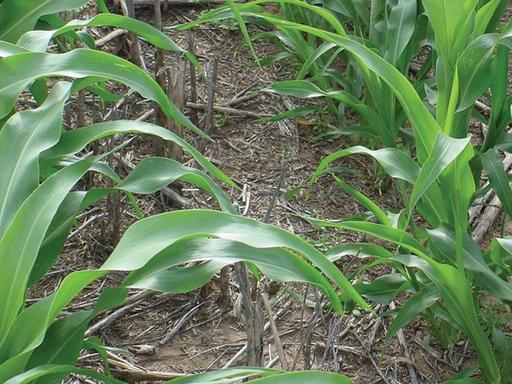
Agricultural News
Organic Matter in No-Till Production Systems
Wed, 21 Dec 2011 15:45:57 CST
 There are many properties influencing soil quality, but one that requires increased attention is soil organic matter. Organic matter is directly related to a number of vital soil functions and can be altered by land management practices. Surface residues protect the soil surface from the detrimental impacts of wind and water erosion. Also, organic materials incorporated into the soil provide an energy source for biological activity, a nutrient source for plants and microbes, and serve as a structural component that improves soil permeability. This Fact Sheet, by Alex Cumbie, Jason Warren and Brian Arnall of OSU, will provide a discussion of these benefits as well as management strategies that increase crop residues and soil organic matter.
There are many properties influencing soil quality, but one that requires increased attention is soil organic matter. Organic matter is directly related to a number of vital soil functions and can be altered by land management practices. Surface residues protect the soil surface from the detrimental impacts of wind and water erosion. Also, organic materials incorporated into the soil provide an energy source for biological activity, a nutrient source for plants and microbes, and serve as a structural component that improves soil permeability. This Fact Sheet, by Alex Cumbie, Jason Warren and Brian Arnall of OSU, will provide a discussion of these benefits as well as management strategies that increase crop residues and soil organic matter.
What is Organic Matter?
Soil organic matter is composed of plant and animal tissue that is at different stages of decomposition within the soil. Soil organic matter must be separated into three basic components to provide a proper discussion of its benefits and management strategies in a no-till system. These three components include surface residues, belowground residues and humus. Humus is most often discussed, however, it is directly tied to surface and belowground residues, and each must be discussed in order to properly understand the role that organic matter plays in a soil system. Surface residues are aboveground plant matter which can be anchored by means of root mass, or simply laying on the soil surface. Belowground residues are partially decomposed organic material, which are located beneath the soil surface, such as roots, dead animals or residues buried by animals. Humus is the stable fraction of organic matter that has undergone humification, where microbes decompose organic residues into dark colored complex structures.
Importance of Organic Matter
Each component of soil organic matter benefits a no-till production system in a different way. Understanding the importance of these components is critical to maintaining a no-till production system.
Surface residues help combat erosion by protecting the soil from water and wind, while simultaneously eliminating the formation of crusts. Prevention of crusting increases infiltration and can improve stand establishment. Surface residues can also reduce evaporative water loss which in turn may increase water availability and potentially increase crop performance. However, all residues are not created equal in regard to soil surface protection (Figure 1). When there are equal amounts of residue, crops like wheat and oats will cover more of the soil surface than a crop like sunflower, due to the fact that sunflower stalks are larger and cannot be distributed as evenly across a field.
Belowground residues are beneficial when it comes to soil structure. They directly influence soil structure by preventing compaction under traffic. In fact, a network of undisturbed roots can serve as a skeleton for the near surface soil. Live roots are much more effective at this function; therefore, intensification of cropping systems so that active root growth is maximized helps reduce traffic compaction. Belowground residues also supply energy for microbes and invertebrates. The decomposition of both above and belowground residue results in the release of proteins and carbohydrates that serve to bind soil particles and improve aggregation. Better soil aggregation means improved permeability for water and roots. All crop residues provide food for macroinvertebrates, such as earth worms, which in turn form biopores that lead to improved permeability of the soil.
Roots that are anchored in the soil tend to contribute a greater percentage of their weight to the formation of humus than aboveground residues. This is due to the fact that crop roots contain more lignin which makes it difficult to break down. For example, Magdoff and Van Es (2009) found that after one year of oat production 33 percent of surface organic matter (residue) was present compared to 42 percent of root organic matter.
The decomposition of organic residues also releases and/or immobilize plant nutrients, in particular nitrogen. Immobilization of applied nitrogen can be detrimental to the current crop, however this nitrogen can be released through mineralization and utilized later in the growing season or by the following crop.
Humus provides several beneficial properties to no-till production systems. Humus decreases crusting and clodding, improves drainage and water infiltration, increases water and nutrient-holding capacity, and reduces erosion. All of these benefits are achieved by means of clay reacting with humus. The surface charges of humus, like those of clay, attract and hold both nutrient ions and water molecules. This interaction allows clay and humus to act as a bridge between larger soil particles. This connection is imperative to the formation of well-structured soil aggregates, which in turn, produce high quality crops.
Click on the LINK below to see a full copy of the Organic Matter Fact Sheet. This Fact Sheet on Organic Matter in No-Till Production Systems was sent out as part of the OSU Plant and Soil Sciences Department Extension News.
02322_OrganicMatterFactSheet12212011.pdf
WebReadyTM Powered by WireReady® NSI
Top Agricultural News
More Headlines...




















